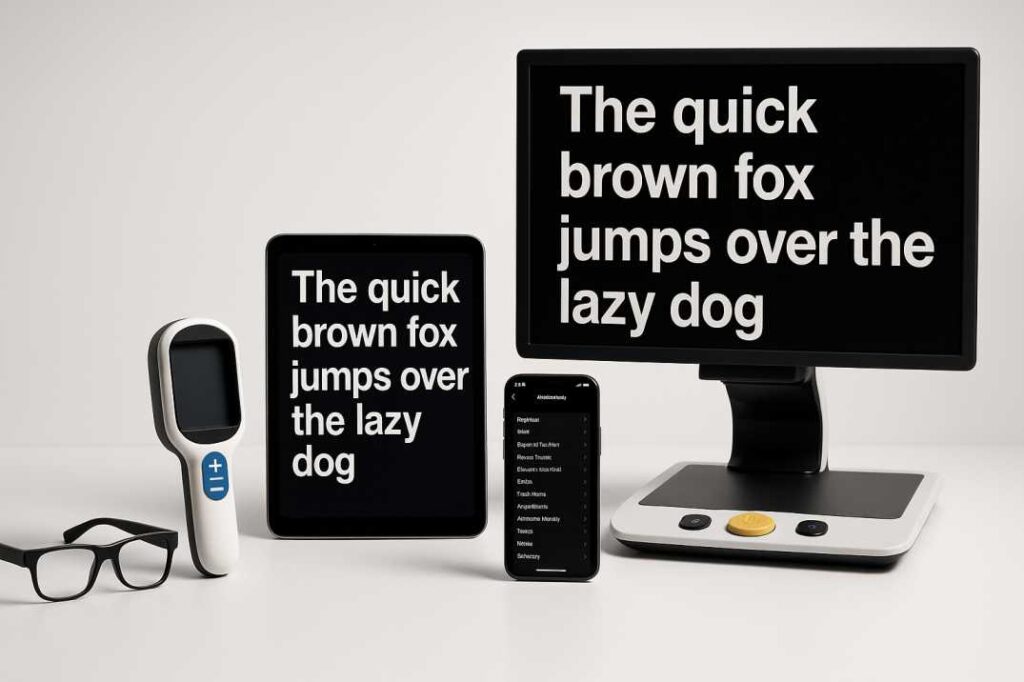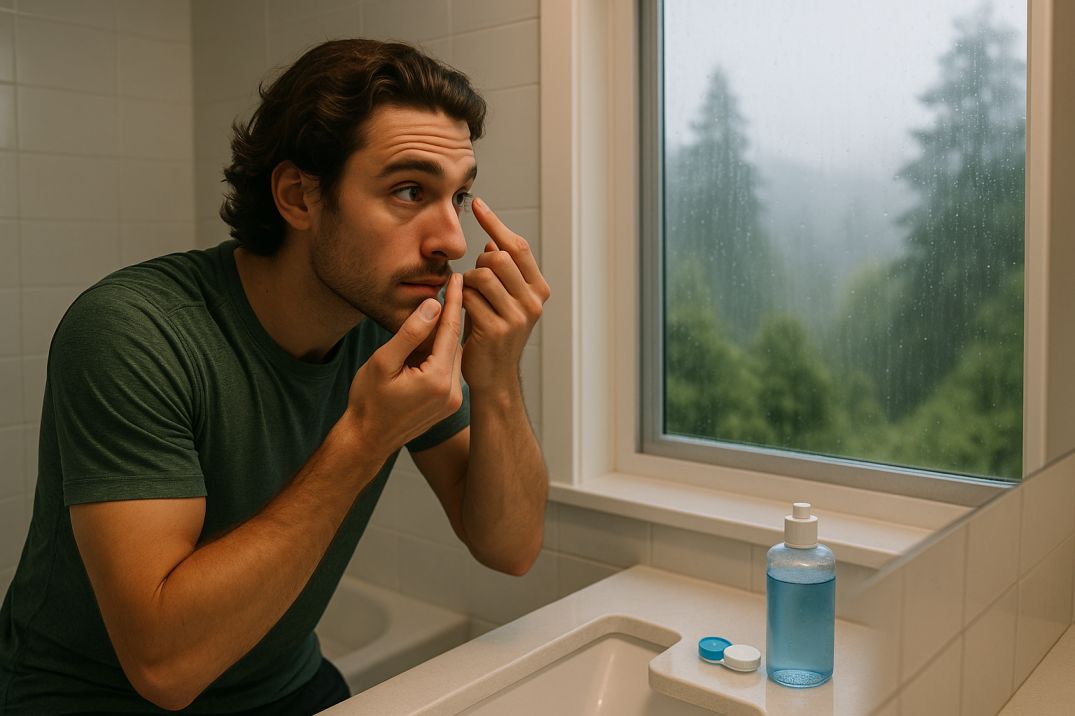Low Vision
Are you struggling with vision that glasses can’t fix? You’re not alone. Low vision affects approximately 4 million Americans and represents a significant visual impairment that cannot be corrected with standard eyeglasses, contact lenses, medication, or surgery. This comprehensive guide will help you understand low vision, explore treatment options, and discover how modern technology is transforming the lives of people with visual impairments.
What Is Low Vision? Understanding the Basics
Low vision is moderate to severe visual impairment that can’t be corrected with prescription lenses or surgery. Unlike total blindness, people with low vision retain some usable vision, but it’s significantly reduced enough to interfere with daily activities.
Key characteristics of low vision include:
- Best-corrected visual acuity of 20/70 or worse in the better eye
- Significant visual field loss
- Difficulty performing everyday tasks despite wearing corrective lenses
- Vision that cannot be improved through medical or surgical treatment
Low vision encompasses various types of visual impairment, including central vision loss, peripheral vision loss, night blindness, and contrast sensitivity issues.
Types of Low Vision
Central Vision Loss: Creates a dark or blurred area in the center of one or both eyes, causing difficulty with activities like reading or distinguishing faces.
Peripheral Vision Loss: The inability to see anything to the side or directly above or below eye level, often described as “tunnel vision.”
Night Blindness: Impaired sight in low-light conditions, making it difficult to navigate in dim environments.
Contrast Sensitivity Loss: Reduced ability to perceive sharp and clear outlines of objects, distinguish objects from their background, and identify small differences in shadings and patterns.
Leading Causes of Low Vision
Understanding what causes low vision helps in prevention and early intervention. The main conditions causing distance vision impairment or blindness globally include cataracts (94 million), refractive error (88.4 million), age-related macular degeneration (8 million), glaucoma (7.7 million), and diabetic retinopathy (3.9 million).
Age-Related Macular Degeneration (AMD)
Age-related macular degeneration affects more than 200 million people worldwide and is a leading cause of vision loss among older adults. AMD damages the macula, the central part of the retina responsible for sharp, detailed vision.
Recent treatment advances for AMD in 2025:
- Gene therapy approaches (RGX-314 and ADVM-022 for wet AMD)
- Stem cell therapy for retinal pigment epithelial cell replacement
- FDA-approved photobiomodulation (Valeda Light Delivery System) for dry AMD in 2024, using red and near-infrared light to boost cellular energy and improve retinal function
Diabetic Retinopathy
People with diabetes can experience day-to-day changes in their vision because diabetes can cause blood vessels that nourish the retina to develop tiny, abnormal branches that leak. This condition affects millions globally and can be prevented or slowed with proper blood sugar control.
Glaucoma
Glaucoma causes damage to the optic nerve, most commonly due to increasing internal pressure in the eye because of problems with the flow or drainage of fluid within the eye. Early detection is crucial, as the most common form has no early symptoms.
Other Common Causes
- Cataracts: Clouding of the eye’s natural lens
- Retinitis Pigmentosa: A group of inherited eye diseases that prevent the retina from working properly, gradually destroying night vision and severely reducing side vision
- Eye injuries and trauma
- Stroke and brain injuries affecting vision
Recognizing Low Vision Symptoms
Early recognition of low vision symptoms can lead to better outcomes and quality of life improvements. Watch for these warning signs:
Common symptoms include:
- Blurry vision during computer work that persists with corrective lenses
- Dry, irritated eyes that don’t respond to typical treatments
- Difficulty seeing at night or in low-light conditions
- Eye strain and headaches despite proper prescription glasses
- Contact lens discomfort that wasn’t previously problematic
- Trouble recognizing faces or reading street signs
- Difficulty distinguishing colors or contrasts
According to Dr. Rebakah Lin, a Low Vision Specialist at Lighthouse Guild, “The three main causes of low vision and blindness in the United States are glaucoma, age-related macular degeneration (AMD), and diabetic eye disease.”
Who Is at Risk for Low Vision?
Low vision is strongly associated with older people because age-related eye diseases most often cause it. At age 45, less than 1 percent of people are likely to have low vision, but by age 75, that jumps to almost 5 percent, and then to 15 percent by age 85.
Risk factors include:
- Age over 45, with significantly increased risk after 65
- Family history of eye diseases
- Diabetes and poor blood sugar control
- High blood pressure
- Smoking
- Excessive UV exposure without eye protection
- Previous eye injuries or surgeries
Comprehensive Low Vision Assessment and Diagnosis
Your doctor can check for low vision as part of a dilated eye exam. The exam is simple and painless, involving reading letters at close and far distances and checking peripheral vision.
What to Expect During a Low Vision Evaluation
A comprehensive low vision assessment differs from a standard eye exam and includes:
Vision Function Testing:
- Visual acuity measurement at various distances
- Visual field testing to map peripheral vision
- Contrast sensitivity evaluation
- Color vision assessment
- Glare sensitivity testing
Functional Assessment:
- Discussion of daily living challenges
- Work and hobby-related visual needs
- Transportation and mobility concerns
- Reading and computer use requirements
Device Trial and Training:
- Testing various magnification devices
- Evaluation of lighting solutions
- Introduction to assistive technology options
Treatment Options and Management Strategies
Unfortunately, low vision is usually permanent. Eyeglasses, medicine, and surgery can’t usually cure low vision — but sometimes they can improve vision, help you do everyday activities more easily, or keep your vision from getting worse.
Optical Aids and Devices
Magnification Solutions:
- Handheld magnifiers with LED lighting
- Stand magnifiers for hands-free reading
- Electronic magnification systems
- Telescopic devices for distance viewing
Computer and Digital Aids:
- Screen magnification software
- Text-to-speech programs
- High-contrast display settings
- Voice recognition software
Cutting-Edge Assistive Technology in 2025
Recent innovations in assistive technology include Eye6 by Eyedaptic (lightweight augmented reality smart glasses), Envision Glasses (AI-powered smart glasses that read text aloud and recognize faces), and Hable Easy (external tactile keyboard for smartphones).
AI-Powered Solutions:
- Smart vision glasses using artificial intelligence and machine learning algorithms, featuring cameras with flashlights, LiDAR sensors, and braille-coded capacitive operating platforms
- Real-time object recognition and description
- Navigation assistance through audio cues
- Text reading and document scanning capabilities
Vision Rehabilitation Services
Low vision rehabilitation services help improve visual ability for millions of people every day, using a combination of lenses, lighting, magnification devices, and non-optical aids to maximize visual function.
Rehabilitation includes:
- Training with assistive devices
- Home and workplace modifications
- Orientation and mobility instruction
- Computer and technology training
- Counseling and support services
Daily Living Strategies and Adaptations
Living well with low vision requires practical adaptations and strategic approaches to daily activities.
Home Modifications
Lighting Improvements:
- Install bright, even lighting throughout the home
- Use task lighting for reading and detailed work
- Minimize glare with adjustable window coverings
- Consider motion-activated lighting for safety
Contrast Enhancement:
- Use high-contrast materials (dark objects on light backgrounds)
- Mark stair edges with contrasting tape
- Choose dishes and utensils that contrast with the table surfaces
- Label items with large, bold text or tactile markers
Technology Integration
Smartphone Accessibility:
- Voice-to-text features and screen readers
- High-contrast display modes
- Camera-based text recognition apps
- GPS navigation with audio instructions
Computer Adaptations:
- Screen magnification software
- Voice recognition programs
- Large-print keyboards
- Audio feedback systems
The Economic and Social Impact of Low Vision
Vision impairment poses an enormous global financial burden with an estimated annual global productivity loss of about US$411 billion purchasing power parity, far outweighing the estimated cost gap of addressing the unmet need of vision impairment (estimated at US$25 billion).
Employment and Independence
According to the U.S. Census Bureau’s American Community Survey of 2018, the employment rate for visually disabled Americans aged 21-64 was 45.4%, with a full-time/full-year employment rate of 30.9%.
Support programs include:
- Vocational rehabilitation services
- Assistive technology funding
- Job placement assistance
- Workplace accommodation consulting
Latest Research and Treatment Breakthroughs
Emerging Therapies and Clinical Trials
Gene Therapy Advances: Gene therapy teaches the eye to produce its own anti-VEGF proteins, with therapies like RGX-314 and ADVM-022 in clinical trials for wet AMD, while HMR59 and GT005 show promise for slowing late-stage dry AMD.
Stem Cell Research: Replacement of damaged retinal pigment epithelial (RPE) cells with healthy lab-grown ones offers potential for repairing retinal damage and restoring vision.
Artificial Intelligence Integration: Recent research on deep learning models for simulated prosthetic vision, incorporating gaze-based optimization and task-specific training, has significantly improved object recognition performance.
Global Research Initiatives
The landscape of low vision research is transforming, driven by the convergence of neuroscience, behavioral science, and technological innovation, with increasing focus on patient-centered, real-world functionality.
Key research areas include:
- Neuro-behavioral insights and rehabilitation
- Caregiver support integration
- Advanced prosthetic vision systems
- Personalized assistive technology solutions
Prevention Strategies and Eye Health Maintenance
Prevention strategies include learning your risk factors for various eye disorders, getting regular eye exams, quitting smoking, wearing UV-protective sunglasses, eating a diet high in dark, leafy vegetables and colorful fruits, and maintaining good blood sugar control.
Comprehensive Prevention Approach
Regular Eye Care:
- Annual comprehensive eye exams after age 40
- More frequent monitoring for those with risk factors
- Early detection and treatment of eye diseases
- Proper management of systemic conditions like diabetes
Lifestyle Modifications:
- UV protection with quality sunglasses
- Smoking cessation programs
- Nutritional supplementation when appropriate
- Regular exercise and weight management
Living Well with Low Vision: Support and Resources
Professional Support Network
Low Vision Specialists: A low vision exam and personalized approach are essential, as a device that works for someone with glaucoma may not work for someone with macular degeneration or retinitis pigmentosa.
Rehabilitation Services:
- Occupational therapy for daily living skills
- Orientation and mobility training
- Counseling and psychological support
- Peer support groups and mentoring
Community Resources and Organizations
National Organizations:
- American Foundation for the Blind (AFB)
- National Federation of the Blind (NFB)
- Lighthouse Guild and regional affiliates
- Prevent Blindness America
Low Vision Technology and Equipment Suppliers:
- Low vision devices demonstrations and trials
- Assistive technology training centers
- Insurance and funding guidance for low vision aids
- Ongoing technical support
The Future of Low Vision Care
Market Growth and Innovation
The global Low Vision Assistive Devices market is experiencing significant growth, with multiple research reports indicating the market size is expected to reach between $1.57 billion $1.73 billion by 2029, with compound annual growth rates (CAGR) ranging from 8.5% to 9.0%. This growth is driven by the emerging usage of intelligent and AI-enabled assistance gadgets and the increasing availability of assistive technology in developing markets.
Emerging trends include:
- Wearable technology integration
- Smartphone app development
- Internet of Things (IoT) connectivity
- Personalized vision assistance ecosystems
Accessibility and Inclusion Advances
Technology continues to play a critical role in enhancing accessibility and inclusivity, with innovations in artificial intelligence, wearable computing, computer interfaces, and personalized assistive solutions empowering individuals with visual impairments to overcome barriers and achieve their full potential.
References and Additional Resources
This comprehensive guide is based on current research and authoritative sources in vision health and low vision care. The following key resources were referenced in developing this article:
Scientific and Medical Sources
-
World Health Organization (WHO) – Vision Impairment and Blindness Fact Sheet
https://www.who.int/news-room/fact-sheets/detail/blindness-and-visual-impairment
Official WHO statistics on global vision impairment, including the 2.2 billion people affected worldwide and the $411 billion annual productivity loss figures cited in this article. -
Centers for Disease Control and Prevention (CDC) – Vision Health Data
https://www.cdc.gov/vision-health/data-research/vision-loss-facts/index.html
Current U.S. statistics on vision loss affecting over 7 million Americans, including prevalence data and demographic information referenced throughout the article. -
Frontiers in Human Neuroscience – Neuro-behavioral Insights on Low Vision Research (2025)
https://frontiersin.org/journals/human-neuroscience/articles/10.3389/fnhum.2025.1652389/abstract
Recent research on the convergence of neuroscience, behavioral science, and technological innovation in low vision rehabilitation, including caregiver support studies and AI-powered assistive technology advances.
Conclusion: Hope and Empowerment
Low vision presents challenges, but it doesn’t define limitations. With proper assessment, appropriate interventions, and modern assistive technology, people with low vision can maintain independence, pursue meaningful activities, and lead fulfilling lives.
Key takeaways:
- Early detection and professional assessment are crucial
- Multiple treatment and management options are available
- Technology continues to provide new solutions and opportunities
- Comprehensive support systems enhance quality of life
- Research and innovation offer hope for future breakthroughs
There’s evidence to suggest that getting low vision services may lower the risk of mortality by helping people maintain activity levels and manage medications properly, while reducing the risk of accidental falls.
If you’re experiencing vision problems that interfere with daily activities, don’t wait. Schedule a comprehensive eye examination with a qualified eye care professional. For those in the Seattle area, practices like Cannon EyeCare offer specialized expertise in low vision evaluation and management, with convenient locations in University Village and Pike Place Market. Their approach combines advanced diagnostic technology with the time and attention needed for thorough assessment – ensuring no detail is overlooked in developing your personalized care plan.
Remember, while low vision may change how you see the world, it doesn’t have to change your ability to engage with it fully. The key is finding the right combination of professional support, assistive technology, and practical adaptations that work for your unique situation.
FAQs
-
Low vision is partial sight that cannot be corrected with glasses, surgery, or medication. Visual acuity ranges from 20/70 to 20/400, while legal blindness is 20/200 or worse




